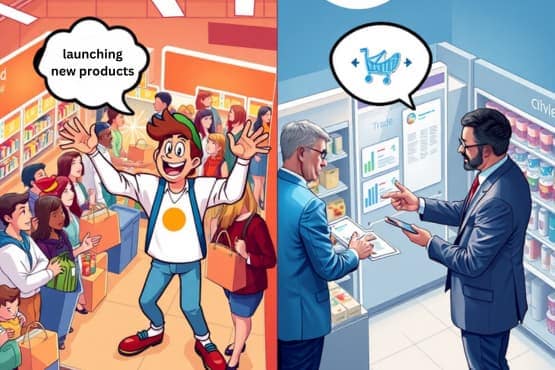Brands navigating the ever-changing retail landscape often face a crucial question: Should they focus on shopper or trade marketing? The answer isn’t simple but lies in understanding how these strategies differ and work together. Let’s dive into how these approaches can boost your sales and build lasting brand loyalty through effective retail marketing strategies.
Key Takeaways
- Shopper marketing targets consumers where they buy, influencing their shopping behaviour.
- Trade marketing builds strong retail partnerships
- Digital tech is reshaping both approaches
- Successful brands blend these strategies for the best results
- Each strategy needs its way of measuring success
What is Shopper Marketing?
Shopper marketing influences consumers’ decisions about where they shop, both in stores and online. It turns browsers into buyers through engaging experiences.

Why is shopper marketing important?
- It boosts impulse purchases.
- It raises brand awareness at the point of purchase, enhancing the consumer goods experience.
- It improves customer loyalty through personalized experiences
A recent study found that 79% of consumers say the shopping experience matters as much as product quality, emphasizing the need for effective retail marketing. This shows why effective shopper marketing is crucial.
Practical Shopper Marketing Tactics
- Design eye-catching store displays
- Offer targeted deals based on shopper data
- Use digital signs for changing messages
- Create loyalty programs with personal rewards to enhance consumer engagement and shopping behaviour.
What is Trade Marketing?
Trade marketing works behind the scenes, supporting the marketing team in enhancing shopper research initiatives. It builds strong ties with retailers and distributors to get products in the best spots and promotions.

Why does trade marketing matter?
- It secures better shelf positions in stores
- It strengthens relationships with retail partners
- It increases brand presence across many channels
A recent survey found that 78% of marketers now use data-driven strategies in their trade marketing. This shows how important this approach has become.
Effective Trade Marketing Strategies
- Attend trade shows to showcase products
- Offer retailers incentives for prominent displays
- Share detailed market insights with retail partners to enhance their understanding of shopper behaviour.
- Team up with retailers on marketing campaigns to leverage category management techniques.
Shopper Marketing vs Trade Marketing: A Comparison

| Aspect | Shopper Marketing | Trade Marketing |
|---|---|---|
| Main Focus | End consumers | Retailers and distributors |
| Key Goal | Influence buying decisions | Secure better product placement |
| Main Tactics | Interactive displays, personal offers | Trade shows, retailer incentives |
| Measurement | Sales increase, conversion rates | Shelf space, retailer satisfaction |
Case Study: Balancing Both Strategies
Shopper Marketing Wins
- Catalina’s Digital Engagement: Catalina, a shopper intelligence firm, ran a digital campaign that showcased the power of targeted marketing. Their efforts generated 27 million ad views and led to impressive results: existing customers spent 42% more per trip, and overall sales jumped by 25%. This case proves how digital strategies can significantly impact in-store behavior.
- L’Oréal’s AR Beauty Revolution: L’Oréal embraced technology with their ModiFace app, allowing customers to try on makeup virtually. This innovative approach to shopper marketing paid off handsomely, boosting their online sales by 49% in 2020. It’s a prime example of how cutting-edge tech can bridge the gap between digital browsing and actual purchasing.
Trade Marketing Success Stories
- Consumer Electronics Market Share Boost: A consumer electronics brand leveraged trade marketing tactics during a crucial product launch. Their efforts paid off spectacularly, resulting in a 30% increase in market share. This case highlights how well-executed trade marketing strategies can significantly enhance product visibility and drive sales performance, especially during critical launch periods.
Measuring Success: Different Strategies
To see if these strategies work, brands need to look at different things:

For Shopper Marketing:
- How much sales go up during promotions
- How many browsers become buyers
- How engaged customers are with the brand
- If people remember the brand after shopping
For Trade Marketing:
- How happy retailers are with the brand
- How much shelf space the brand gets
- If trade promotions are worth the cost
- How the brand’s market share grows
The Future of Shopping and Selling
New tech is changing shopper and trade marketing, impacting how we approach in-store experiences.

- AI-Powered Shopping: AI makes shopping more personal. For example, North Face uses AI to help shoppers find the perfect jacket by asking about their needs and preferences.
- Blockchain in Trade: This tech clarifies supply chains, benefiting the marketing team and trade marketing efforts. Walmart uses blockchain to track food from farm to shelf, building trust with retailers and shoppers.
- Voice Shopping: As more people use smart speakers, brands are adapting. About 45% of smart speaker owners have used voice commands to shop.
- IoT and Smart Shelves: Internet of Things (IoT) devices like smart shelves can track product stock in real time. This helps brands and retailers keep popular items available and adjust pricing.
- 5G and Augmented Reality: Faster 5G networks will make AR experiences smoother. Imagine pointing your phone at a product to see reviews, recipes, or how it looks in your home – all instantly.
E-commerce: Where Shopper and Trade Marketing Meet
Online shopping has blurred the lines between shopper and trade marketing. Here’s how brands can adapt:

- Optimize Product Listings: Use keywords that shoppers search for and align with marketplace algorithms to optimize in-store promotions. This helps with both shopper discovery and “digital shelf space.”
- Digital Trade Marketing: Use sponsored product ads and banner placements on e-commerce platforms. This is like negotiating for eye-level shelf space in a physical store.
- Personalized Recommendations: Use customer data to show relevant products. This combines the personalization of shopper marketing with the placement strategy of trade marketing, informed by shopper research.
- Content Marketing: Create helpful product guides, videos, and blog posts. This attracts shoppers and can improve your standing with e-commerce platforms.
- Marketplace Insights: Many e-commerce platforms offer data similar to trade marketing insights. Use this to adjust your strategy in real-time, ensuring alignment with consumer goods trends.
How to Choose Between Shopper and Trade Marketing

While it’s best to use both, here’s when to focus on each:
Use more shopper marketing when:
- You’re launching new products
- You want to win more market share
- You’re aiming to boost impulse buys
Lean on trade marketing when:
- You’re entering new markets
- You need to improve store relationships
- You want to boost your overall presence in stores
FAQs
How can small businesses do effective shopper marketing?
Small businesses can try these budget-friendly tactics:
- Use social media to encourage customers to share photos with your products
- Create eye-catching, DIY store displays
- Offer limited-time deals to create urgency
- Team up with nearby businesses for cross-promotions
What challenges do brands face when balancing shopper and trade marketing?
Brands often struggle with:
- Keeping messages consistent across all channels
- Splitting the budget fairly between both strategies
- Figuring out if each approach is paying off
- Staying true to the brand while meeting different store needs
To overcome these, keep teams talking, use software that brings all your marketing data together, and regularly check and adjust your plans based on what’s working.
How has online shopping changed the game for shoppers and trade marketing?
E-commerce has greatly mixed things up, changing shopper behaviour and retail marketing dynamics.
- Online shopper marketing tactics like personalized recommendations directly affect your “shelf space” (search rankings and product placement)
- Brands must optimize their product listings for search engines and marketplace algorithms.
- Digital trade marketing now includes things like sponsored product ads
- Data analytics help inform both strategies in real-time
What new technologies should marketers keep an eye on?
Some exciting tech to watch includes:
- Augmented Reality (AR) for virtual try-ons and product visualization
- Internet of Things (IoT) for smart shelves and inventory tracking
- 5G networks enable more sophisticated location-based marketing
- Advanced AI for predicting consumer behaviour and optimizing supply chains
How can brands track the long-term impact of shopper and trade marketing efforts?
To gauge long-term success:
- Track how people view your brand over time (awareness, loyalty, perceived value)
- Monitor how much a customer is worth to you over their lifetime
- Watch how your market share grows compared to your marketing spend
- Regularly ask retailers how they feel about working with you
- Use tools that show how different marketing touchpoints work together
By using these strategies and keeping up with new trends, brands can create a potent mix of shopper and trade marketing. This approach drives quick sales and long-term growth, helping you stand out in today’s competitive retail world.




